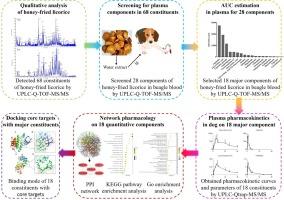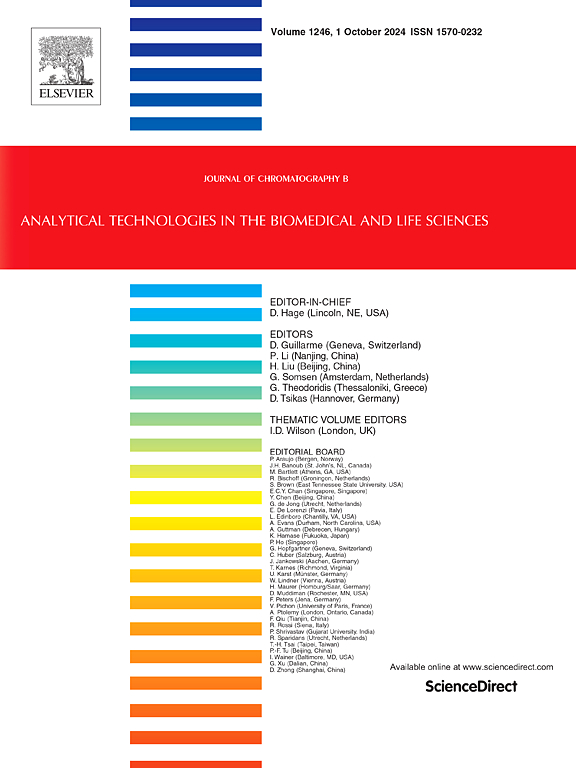蜜炒甘草的药代动力学分析和网络药理学:研究传统中药 (TCMs) 的综合工作流程。
IF 2.8
3区 医学
Q2 BIOCHEMICAL RESEARCH METHODS
引用次数: 0
摘要
甘草被称为 "长寿药",常用于传统中药配方中。本研究旨在建立一个结合动物实验和硅学实验的工作流程,从定性和定量两个层面阐明中药的作用机制。本研究采用UPLC-Q-TOF-MS/MS定性分析蜜炒甘草的总成分以及比格犬口服后血浆中的成分。开发了一种 UPLC-Q-Trap-MS/MS 方法,用于比格犬血浆中蜜炒甘草成分的药代动力学研究。我们利用网络药理学和分子对接来探索主要的功能靶点和途径。我们共鉴定出蜜炒甘草中的68种成分,在比格犬血浆中检测到28种,其中18种主要属于黄酮类和萜类化合物,表现出显著的暴露。对这18种成分进行的血浆药代动力学研究显示,桔梗苷、甘草酸、甘草皂苷G2和甘草亭酸-3-O-葡萄糖醛酸苷等化合物具有显著的暴露量。网络药理学和分子对接分析发现,MAPK3、PIK3CB、PIK3CA、RAF1 和表皮生长因子受体是蜜炒甘草活性成分的主要靶点,它们参与了 Ras 信号通路、人类巨细胞病毒感染和 MAPK 信号通路等途径。本研究提供了蜜炒甘草的全面概况和药代动力学特征,有助于深入了解其药理、毒理和临床方面的情况。所建立的工作流程可作为研究其他中药的标准。本文章由计算机程序翻译,如有差异,请以英文原文为准。

Pharmacokinetic profiling and network pharmacology of honey-fried Licorice: An Integrative workflow to study traditional Chinese medicines (TCMs)
Licorice, known as the “elder statesman,” is commonly used in traditional Chinese medicine (TCM) formulations. This study aims to establish a workflow combining animal and in silico experiments to elucidate the mechanisms of TCMs at both qualitative and quantitative levels. UPLC-Q-TOF-MS/MS was employed to qualitatively characterize the total components of honey-fried licorice and the plasma components after oral administration in Beagle dogs. A UPLC-Q-Trap-MS/MS method was developed for the pharmacokinetic study of honey-fried licorice components in Beagle dog plasma. Network pharmacology and molecular docking were utilized to explore the primary functional targets and pathways. In total, we identified 68 constituents in honey-fried licorice, with 28 detected in Beagle dog plasma, and 18 of them, mainly belong to flavonoids and terpenoids, showing significant exposure. The plasma pharmacokinetic study of these 18 constituents revealed that compounds like liquiritin, glycyrrhizic acid, licoricesaponin G2, and glycyrrhetic acid-3-o-glucuronide had significant exposure. Network pharmacology and molecular docking analyses identified MAPK3, PIK3CB, PIK3CA, RAF1, and EGFR as the main targets of the active constituents of honey-fried licorice, involved in pathways such as the Ras signaling pathway, human cytomegalovirus infection, and the MAPK signaling pathway. This study provides a comprehensive profile and pharmacokinetic characteristics of honey-fried licorice, offering insights into its pharmacological, toxicological, and clinical aspects. The established workflow can serve as a standard for investigating other TCMs.
求助全文
通过发布文献求助,成功后即可免费获取论文全文。
去求助
来源期刊

Journal of Chromatography B
医学-分析化学
CiteScore
5.60
自引率
3.30%
发文量
306
审稿时长
44 days
期刊介绍:
The Journal of Chromatography B publishes papers on developments in separation science relevant to biology and biomedical research including both fundamental advances and applications. Analytical techniques which may be considered include the various facets of chromatography, electrophoresis and related methods, affinity and immunoaffinity-based methodologies, hyphenated and other multi-dimensional techniques, and microanalytical approaches. The journal also considers articles reporting developments in sample preparation, detection techniques including mass spectrometry, and data handling and analysis.
Developments related to preparative separations for the isolation and purification of components of biological systems may be published, including chromatographic and electrophoretic methods, affinity separations, field flow fractionation and other preparative approaches.
Applications to the analysis of biological systems and samples will be considered when the analytical science contains a significant element of novelty, e.g. a new approach to the separation of a compound, novel combination of analytical techniques, or significantly improved analytical performance.
 求助内容:
求助内容: 应助结果提醒方式:
应助结果提醒方式:


